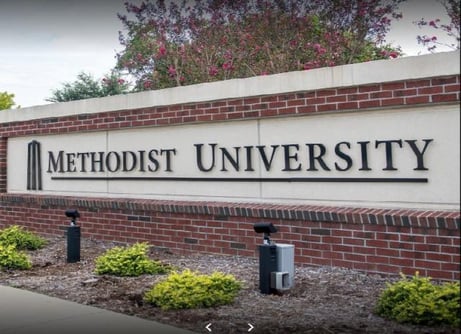Paving The Way: Methodist University
A Case Study in Student Success, Retention & Culture Change
 Methodist University started its Moving the Needle (MTN) partnership with Credo in early 2020. Despite the hurdles presented by the COVID-19 pandemic’s early days, Methodist persevered, carefully balancing emerging student success needs with long-term strategies designed to improve retention. Thanks to the strong collaboration of many offices, faculty, and staff across campus, Methodist made steady progress toward its retention goals while ensuring its students continued to thrive during turbulent times.
Methodist University started its Moving the Needle (MTN) partnership with Credo in early 2020. Despite the hurdles presented by the COVID-19 pandemic’s early days, Methodist persevered, carefully balancing emerging student success needs with long-term strategies designed to improve retention. Thanks to the strong collaboration of many offices, faculty, and staff across campus, Methodist made steady progress toward its retention goals while ensuring its students continued to thrive during turbulent times.
Balancing Immediate and Long-Term Student Needs
Faculty and staff at the small, private university based in Fayetteville, N.C., faced two primary roadblocks in improving student success and retention:
- University units related to student success operated within disconnected siloes. Individually, these units offered valuable assistance to students—but collectively, they did not systematically collaborate or communicate. As a result, students had difficulty figuring out which offices they needed to work with to solve different problems.
- Outdated technology, systems, and processes needed to be improved or replaced to better reflect a holistic approach to student success that better balanced recruitment and retention.
"Having the Credo partnership gave us the buy-in, resources, and authority to back up the need for the changes we had all been contemplating. Credo provided for us a space, system, and pathway for the changes to take place."
Dr. Doris Munoz Assistant Provost, Student Retention and Persistence Initiatives at Methodist University
Centralizing and Streamlining Processes and Services
In addition to the critical work campus staff engaged in to manage and respond to the pandemic, Methodist focused on addressing areas foundational to improving student success and retention.
In 2021 Methodist created a new position: Assistant Provost, Student Retention and Persistence Initiatives, now held by Doris Munoz. Munoz coordinates all of Methodist’s efforts related to student success and serves as the university’s MTN project manager. One of her biggest responsibilities is overseeing Methodist’s One-Stop center, which houses academic and career advising, academic support, and student financial services. Centralizing these key areas of the student experience has vastly improved students’ ability to find the assistance they need and develop deeper relationships with their advisors.
Methodist also focused on improving the student experience related to onboarding, including financial services and registering for classes. The university developed collaborative intervention strategies among units to share information about students and the barriers they may encounter to returning for the next semester. This work also contributed to the creation of The Monarch Way, an online checklist that helps students know exactly what they need to do each semester to remain in good standing.
These improvements, among others, helped Methodist increase its retention over 5% points in the first three years.
Creating, Implementing & Learning: Student Success Strategy in Motion
Looking forward, Methodist is focused on:
- Creating a strategic Student Success/Retention Committee that represents all parts of the campus.
- Implementing the Success Intelligence Platform powered by Pharos Resources to inform intervention work.
- Changing policies and systems to better meet the needs of today’s student.
- Learning more about the student success needs of specific populations, such as Pell-eligible, first-generation, and military-affiliated students.
By fostering collaboration, centralizing key student services, and implementing technology-driven strategies, Methodist has enjoyed significant early success despite the initial challenges presented by the pandemic. The university is well positioned to continue and sustain this progress and ensure a thriving educational experience for its students, now and in the future.
Additional Resources
- Methodist College Strategic Initiative
- Moving The Needle On Student Success
- Longer-Term Impacts of Moving The Needle
